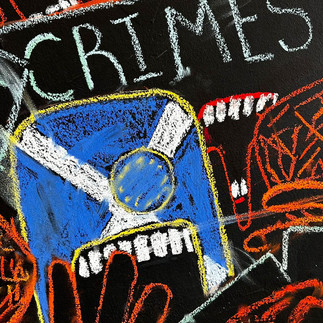Richard Demarco, Eurovision and the Brexiles Exhibition in Edinburgh
- Madeleina Kay
- May 12, 2024
- 11 min read
After our MA teaching session on Thursday, I realised that I hadn’t prepared anything for the trip to Edinburgh the following day. So in a mad 3-hour panic; I rehearsed the songs I was going to perform, got the paintings out of the roof (which is a bit of an ordeal as the box is wider than the latch-door), packed my suitcase (I decided to take the huge case as it meant I could balance the enormous box of paintings on the top and use it like a trundle trolley), updated the digital “information booklet” about the "Brexiles" exhibition, printed out new QR codes to put up around the venue, found all the bits and bobs I needed for the install, liaised with the organisers about the travel arrangements – and then collapsed in an exhausted heap whilst the cats proceeded to pull the tape off the box of paintings (they are always so helpful).
The lift at Sheffield station was, of course, broken. A sign said to ask for assistance but there was no staff on the concourse or information desk (surprise, surprise). So, I had to break the “do not leave unattended luggage in the station” rule and run up and down the stairs carrying one hefty item at a time. Otherwise, the journey, (remarkably, given that it was the day after a train strike) went to plan - although the train was absolutely rammed and extremely hot, so I was very sticky by the time I got to Edinburgh. Since I had so much cumbersome luggage, I started getting off the train well in advance, only to be stopped by a father and son who had just bought a guitar from a shop in Newcastle and were wondering who the other guitar (in the luggage rack) belonged to… After a lengthy “guitar chat” - the father kindly offered to help me off the train with the paintings. We were greeted on the platform by two of the organisers (Danuta and Keith) from Euromove Scotland who took the box of paintings of him. It was an extremely friendly (and typically) Scottish welcome!
We went immediately to the venue – Summer Hall, where we proceeded in a vain attempt to hang the entire exhibition in the space of two hours (which wasn’t possible), before heading to Keith’s home where his wife had prepared a lovely dinner for us and some of the speakers who were staying with them. We had to return at 8am the following morning to hang the rest of the paintings – but we managed it before the event started. I had my trusty spirit-level key chain (the most useful Christmas-cracker tat I’ve ever had) – which is perfect for getting the paintings level.
We had five easels, and a ledge which were fairly easy to situate the canvases on (with the assistance of some blu tack), the difficulty was hanging the rest of the paintings on invisible wire from a picture rail which jutted out from the wall – leaving them suspended in mid-air (admittedly, they did cast cool shadows on the wall behind). We devised a forgiving pattern, which would allow us to hang the paintings without the need to waste precious time arranging them in a perfectly straight line. Overall, I was pleased with what we achieved given the time constraints. I was also delighted to find a sting of crocheted EU flag bunting in one of the boxes of stuff, and hung it above my Brexiles’ paintings on the back wall. It was delightful to work with such a pro-active, patient and supportive team, again – I always feel blessed when everyone is so lovely.

I stayed at Danuta’s home, and she was the most welcoming host – even to the point of ensuring that I had Vegan-friendly shampoo and conditioner to use. When we got to Summer Hall at 8:30am the following day, everyone from Euromove Scotland was buzzing with excitement getting the venue ready whilst we put up the remaining paintings.

Keith and Danuta "letting the light in".

Lots of people came up to me to ask about the “Brexiles” portraits – I think the concept hadn’t been communicated properly, as I kept getting questions which indicated that people hadn’t understood the term “Brexiles”. Fortunately, I had five minutes allotted (after the first coffee break) to talk about the exhibition and clarify the concept and methods behind the research project. Having previously presented the project in a 3 minute speech - 5 minutes seemed like an abundance of time to cover what I wanted to say; I explained the word “Brexiles”, how I found the research participants (through social media), read out a few quotes from their interviews, gave some examples of the symbolism behind the colour schemes and then read out my (1 min 30 sec) poem summarising the project (instead of boring them with an academic analysis of my research findings). It went down well, in fact, Danuta told me afterwards that I had conveyed more in the space of 5 minutes than any of the other speakers had in speeches up to 30 minutes. I appreciated that: I like to be concise, bold and impactful.
In the lunch break, I was taken down to the Demarco Archives (in Summer Hall) where I was told Scottish artist, Richard Demarco CBE, would be talking to visitors. It turned into an intense 2-hour conversation, which Danuta had to drag me out of, in order that I could practice before my performance in the evening. Demarco turned out to be quite a character, despite his 93 years of age – he captivated the room. I felt a resonance between my own art practice and the philosophy behind his creative work.

One of the organisers introduced me to him and I gave him copies of my “Brexiles” and “The Future is Europe” books. I think he was impressed by them – when I explained that I had interviewed 27 British citizens who had left the UK because of Brexit – he exclaimed “I need these people! Where did you find them? I need to communicate with these people”. I told him I had used social media and he asked how many followers I had – about 40,000 across platforms – He said that he loved that I was talking to so many people about Europe.

He told us about the archives and his work, including winning the European Citizen’s Prize and bringing 250 members of the European Parliament to Edinburgh – explaining that “local politicians… are trained only to think in limited ideas of Britain and it’s problems – Britain’s problems are self-inflicted… If you listen to any politician now they are only interested in their pathetic, local politics. Labour is going to save us? Oh they can’t. Neither can the Tories. Neither can the Liberals. Because it’s people speaking the language of division rather than coming together.” He continued, “Every single exhibition I have ever done is about Europe – and the Arts Council hated me for that!” which made the entire room laugh. He had some interesting perspectives on the contemporary art world, and when I told him that I was studying at Central Saint Martins, he said it was an “awful place” and that all art schools had been taken over by big business. I empathised with him but explained that, since I don’t have a BA degree, I “desperately need a piece which tells people I’m not stupid” because I have been denied opportunities (such as a traineeship at the European Parliament and the House of European History Museum) because of my lack of qualifications. Demarco explained his opinion, “the art world is run by people who are listening to the politicians… The art world is a big bloody knees up… If you identify yourself with the art world, you identify yourself with a meaningless group of human beings who are only interested in entertainment… Art centres are not serious places, so don’t think the art world is going to save you – it isn’t.” He added a further, rather poignant point, “I hate the idea of buying art - art is a gift to humanity”. This is an opinion that I share, I hate commercial dealings regarding my art, obviously I do it but I loathe it. I also believe that the art sector – which is in no way meritocratic - is very poorly suited to a capitalist model and this is why you have huge imbalances of value, embezzlement, commodification of artist’s work and the vast majority of artists earning well below the living wage. My preferred model of funding dissemination of my art is to crowdfund (printed books, performances, exhibitions, etc.) so that I can distribute my art work freely to audiences. If I became a “commercial” artist, I think the nature of my work would become so distorted by trying to make marketable “products” that I would lose my sense of self and my work would become meaningless.
Demarco also told us that he’s “taught in a Primary School…. Every single child is already an artist – that’s their birth rite … we’re born to be great human beings.” I thought this was a beautiful thing to say and I immediately though of the primary schools where I have given book talks and performances. I showed home some photos from my recent performance at Plattling Gründschule in Bavaria – including all the drawings and little gifts the kinder had made for me. Demarco was excited by this and told me that “their artwork is far more important than your’s” – I had to agree. He asked me to send him the photos of the children and their artworks, so we exchanged contact information.

He also spoke about the “Europe Talks – Festival of Europe” event we were attending,
“I think this conference is very important and Niamh has done a fantastic job” but he expressed concern that we were preaching to the converted and everyone in the room was sympathetic to our cause. As it turned out, someone from “Anti-globalist” Guerrilla News media turned up to film at our event – so, we were at least reaching an anti-EU audience through their channel. I also told Demarco that I had many trolls on my social media, so I have “broken out of the echo chamber” and the posts I made from the event would get their attention through my channels. I told him that I frequently attend events where everyone is wearing suits and I “annoy them” with my blue hair and sparkly clothes. He said that I need a “disguise” so that people couldn’t identify me as “an artist” – but I disagreed. Authenticity and free expression are incredibly important to me, and I don’t want to aesthetically conform to tedious, formal attire – I want people to know what I stand for and if it irritates them, well good, I’m glad. And if my outfit brings them joy (which it often does) then I have made a positive connection with someone. Also, when I where a suit, I look like a Tory – which disgusts me.

After that very intense conversation, I went to the room where the drinks reception was being held, so that I could practice my songs ahead of the performance. The evening event was very joyful and I performed after a few speeches, introducing myself as the “Eurovision warm-up act”. I sang my very political songs, given the nature of the event, ‘We Are Europe’, ‘It’s Time To Vote’ and ‘We Won’t Go Down Without A Fight!’ – the latter two, have a very simple chorus, so I got everyone to sing with me. It was a beautiful moment of a community coming together – I was so grateful to be part of it. Having said that, the temperature was extremely (and unusually) hot in Edinburgh that weekend and I was sweating by the end of the performance – so, I was glad to get off the stage by the end.

That evening we went back to Danuta’s house to watch the Eurovision, with her dutch, PhD student, lodger. I really enjoy watching Eurovision with other people - I feel very sad when I watch it alone. I particularly enjoy the very silly performers with the outrageous costumes and bizarrely hysterical lyrics – I don’t like it when performers take themselves too seriously. Aptly, Danuta had an artwork in her home with a Wittgenstein quote, ‘Never stay up on the barren heights of cleverness, but come down into the green valleys of silliness’. I crashed out before the voting was announced, but woke up to discover Switzerland had won, I was glad – I genuinely thought they had a great song and I loved the stylisation and aesthetic of their performance.

Finland won the prize for the most silliness.
By sheer coincidence, after my 1-to-1 tutorial with Jonathan, who had recommend I look at “craftivist collective” – Danuta had just bought a copy of the “Craftivist Handbook”. She gave it to me to look at, and I speed-read it whilst I was there, taking photos of the important bits – so I can refer back to them later. I will write up another blog post on that shortly.

In the morning it was back to Summer Hall for the second day’s activities. The venue was even busier due to the high calibre of the guests (including many MPs) – I gave them all copies of my “The Future is Europe” book.

Photo-bombing Angus Robertson MSP and the chair of Euromove Scotland.
Unfortunately, I had to take my exhibition down during the lunch break, as I couldn’t stay until the end of the day – as the last direct train was before the end of the schedule and there was absolutely no chance that I could get all of the luggage and box of paintings on and off connecting trains by myself. I also didn’t want to stay an extra night as I have to travel to Romania on Tuesday. It was a shame, but systematic of trying to cram too much into my calendar (as per usual).
The ceiling in the venue had an interesting artwork called 'The Odyessy' and the "grand staircase" was adorned with international flags.

Before I left, I made sure to wander round the other exhibitions in Summer Hall, which include an incredible diversity of artworks – it really is an amazing “Art Village”.
I was particularly delighted to find a chalk mural in the stairwell which summed up my exact sentiments on Brexit. I’m starting to think I need to move to Scotland – they definitely get my vibe far more than the English - and I wouldn't have to get a visa to move there!

If you could sum up my feelings about Brexit in an artwork this would be it...
By depositing a box of my 'The Future is Europe' books with Euromove Scotland, I was hoping to leave Edinburgh with less stuff than I came – no such luck! I managed to acquire so much “EU swag” from the various stalls (including the European Parliament liaison office) and kind gifts from the organisers, that I think I left with more than I arrived!
Fortunately, Keith was on-hand to drive me to the station and help me carry the luggage and paintings onto the train. He said he hoped they’d fixed the lift by the time I got back to Sheffield, as I had to manage that bit alone – I replied that it was “unlikely – but I would manage”. In the end, a nice lady saw me struggling and offered to help me shift my suitcase down the stairs.

With the "crafitivist" who made the lovely EU blue and yellow patchwork quilt which she donated as a raffle prize (I was informed that raffles are the national past-time in Scotland).

It was honestly such a wonderful weekend, to share so many thought-provoking conversations and to spend time with so many lovely people who were extremely kind, generous and caring. They kept thanking me for making the effort to come with my paintings, but I could only thank them in return for everything they did to support my work and the opportunity to meet so many interesting and passionate people. I was given so many business cards at the event, that I can't for the life of me remember who gave me which one now!

Danuta sent me a sweet message after I left..

Trolling
There’s been a small amount of trolling but nothing too severe.
















































留言